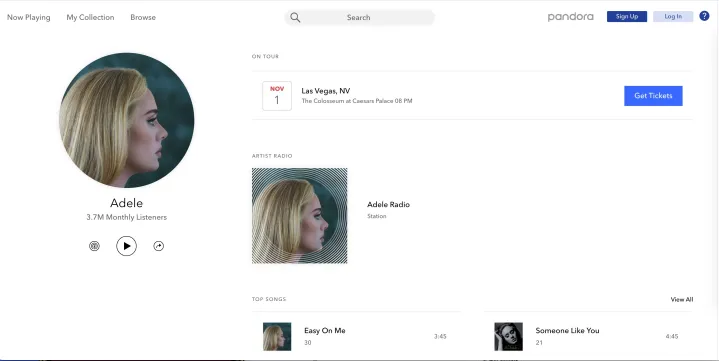Let’s settle a musical debate: which music streaming platform should you use: Spotify or Pandora?
Both services have their unique strengths and weaknesses. Spotify boasts a more extensive music catalog, robust social features for sharing and discovering music with friends, and a more polished user experience across devices.
But don’t count out Pandora just yet. Its robust Music Genome Project algorithm excels at surfacing new music you’ll love based on detailed song attributes. And with a cheaper $5 per month ad-free radio tier, it’s more budget-friendly than Spotify Premium.
From music discovery capabilities to podcast support to cost and third-party integration, we’ve thoroughly compared every key aspect of these streaming giants. The verdict on which service comes out on top may surprise you.
Background
For better or worse, Pandora’s Music Genome Project revolutionized the music industry when it debuted in 2000, creating a new standard for online music streaming. Since then, numerous competitors have sprung up, with iHeartRadio, Last.fm, TuneIn, and others borrowing Pandora’s “radio station” model with varying degrees of success. Pandora was so successful at radio-style programming that SiriusXM acquired it in 2019, and it’s had a presence in the music streaming service market ever since.
Meanwhile, Spotify was conceived by two Swedish businessmen who wanted a way to listen to all their favorite music in the same place. The service debuted in 2008 and has since gone gangbusters, growing into one of the most successful on-demand music platforms globally, with more than 626 million monthly active users and 246 million premium subscribers across 184 regions. While Apple Music is the only on-demand service that comes close to matching Spotify’s might, Pandora’s on-demand service offers several compelling reasons to try it.
Music catalog

For years, Spotify has held a significant advantage in the music streaming category, boasting tens of millions of songs in its ever-expanding library. In contrast, Pandora’s catalog was once quite limited, including only about 1 million to 2 million songs. While this is still a respectable number, it was not enough to compete with Spotify or Apple Music. However, after acquiring Rdio, Pandora secured deals with several major record labels, enabling it to launch Pandora Premium and expand its offerings.
Although Spotify’s track count stands at more than 100 million, primarily due to remixes, covers, original content, and contributions from amateur artists, the libraries of Spotify and Pandora have become quite comparable. No major artists are available on one service but not the other. Some artists may have exclusive agreements with different platforms, while others choose to keep their music off streaming services entirely. While Spotify maintains a slight edge in raw numbers, the differences between the two services are minimal — rest assured, most people are likely to find what they’re looking for on both services.
Winner: Tie
Social features
Both Pandora and Spotify recognize the social power of music and offer features to connect users. However, their approaches differ significantly. Pandora’s social features are limited, focusing mainly on sharing stations across Facebook and X (formerly Twitter). This feels restrictive, especially since on-demand playback requires a subscription. Furthermore, Pandora’s integration with other social media platforms, like Instagram, lagged behind Spotify.
In contrast, Spotify provides a rich social experience. Users can share songs, playlists, and artists across platforms like Facebook, Threads, WhatsApp, Instagram, and Telegram. Spotify’s barcode feature simplifies music discovery, and collaborative playlists enhance the shared listening experience. Spotify’s commitment to expanding its social features solidifies its position as the more social music streaming platform.
Winner: Spotify
Music discovery

Everybody wants to find musical diamonds in the rough, and a big part of a streaming platform’s value comes from its ability to help users find new tunes. Music discovery is the backbone of Pandora. The Music Genome Project we mentioned above is the engine that drives Pandora. It offers the uncanny ability to provide listeners with songs they like based on over 450 attributes, down to the unique cocktail of instruments, vocals, and pacing that make the song what it is. In addition to creating radio stations, the Music Genome Project helps curate playlists (if you have Pandora Premium) by automatically adding music once you have selected a few songs. As of 2022, the Music Genome Project had analyzed 2.2 million songs, with Pandora stating that “none of our competitors can come close to the depth of our content understanding.”
Spotify is relatively high in this category, too, and the company has made acquisitions to get better at it over time. The extremely popular “Discover Weekly” playlist, a 30-song list that magically shows up each Monday, blends music you love with music you’re likely to love. Spotify is constantly adding similar features so you can keep discovering. Spotify’s home interface is also brimming with themed playlists, and you’re just one click away from the “Discover” tab, which features personalized recommendations based on your listening history.
We’re still inclined to give Pandora the nod here, however. After all, music discovery is its primary function, and its radio stations far outshine Spotify, which too often seems to blend genres and repeat tracks.
Winner: Pandora
Podcasts
While both Spotify and Pandora have expanded beyond music to include podcasts in their libraries, Spotify has emerged as the clear leader in this arena. Although both platforms offer popular podcasts and boast exclusive content, Spotify’s market dominance has given it a significant edge. This is evident in the widespread presence of Spotify’s logo among the top podcasts’ official destinations. Moreover, Spotify’s acquisition of The Ringer in 2020 signaled a strategic move into sports content, further strengthening its position in the podcast market, as did the company striking a deal with Joe Rogan that same year. Consequently, Spotify takes the lead in this category, leveraging its existing popularity and strategic acquisitions to solidify its dominance in the growing podcast landscape.
Winner: Spotify
Free versus paid versions

Both Pandora and Spotify offer tiers with free music streaming with ads, but their approaches differ significantly. Pandora’s free tier focuses on personalized radio stations. You can refine these stations by giving songs a “thumbs up” or “thumbs down,” but on-demand access is locked behind a paywall. Free Pandora accounts also have lower audio quality and lack a desktop client. Spotify’s free tier provides more flexibility with on-demand access through the desktop and web apps. Mobile users can enjoy on-demand listening from curated playlists. Both services limit audio quality and include ads in their free versions.
If you’re considering a premium subscription, both offer free trials. Pandora provides a longer trial period for both its Premium and Plus services, while Spotify offers a 30-day trial for its Premium service, which allows you to download music to your devices. Both also offer discounts for annual memberships. Ultimately, the best choice depends on your listening preferences. If you enjoy discovering new music through curated stations, Pandora might be a good fit. Spotify could be the better option if you prefer on-demand access to a vast music library.
Winner: Spotify
How much are they?
When it comes to affordability, Pandora takes the lead with its compelling $5-per-month tier. This option is perfect for budget-conscious music lovers who crave an ad-free experience without the hefty price tag of Spotify Premium’s $12 monthly subscription for its Individual plan. While Spotify caters well to free users with its generous ad-supported plan, Pandora’s mid-tier pricing makes it a winner for those seeking value.
Both platforms offer family plans, with Pandora’s priced at $18 per month and Spotify’s at $20. Spotify provides additional options like Duo ($17) plans for couples and discounted student subscriptions ($6), increasing flexibility. However, both services frequently offer promotions, including free trials and discounts tied to device purchases or partnerships, making it worthwhile to keep an eye out for deals.
Both companies make it relatively easy to cancel or downgrade service at any time if you need a break.
Ultimately, Pandora’s $5 plan gives it a significant edge in the pricing battle, making it an attractive choice for cost-conscious music enthusiasts.
Winner: Pandora
User interface and experience
Both platforms boast sleek designs across smartphones, tablets, and desktops, but their user experiences differ. Pandora offers a consistent experience through its mobile app, in-browser player, and desktop program (for Plus/Premium users). Its interface is clean and intuitive, featuring alphabetical and date-based station sorting, artist background information, lyrics, and quick buy links. Pandora’s unique “Music Genome Project” adds a cool layer of song analysis. Voice control is a standout feature, allowing hands-free control with commands like “Hey Pandora, play something awesome.”
Spotify also delivers a polished interface across its web, desktop, and mobile apps. Its desktop version is particularly user-friendly with a Google-like search function that auto-generates results. Mobile navigation is streamlined with “Home,” “Search,” and “Your Library” tabs. Spotify excels in music discovery, offering curated playlists, personalized recommendations within the search interface, and “Endless Artist Radio” based on listening history. Spotify is also the king when it comes to frequently adding innovative new features, such as it’s recently-launched AI Playlist generator that lets you enter in text prompts for pretty much anything, and its new playlist cover art creator.
While Pandora offers a solid experience, particularly with its voice control, Spotify ultimately provides a more well-rounded and sophisticated user experience. Its superior platform and intuitive interface give it the edge.
Winner: Spotify
Third-party integration
We talked about mobile and desktop apps above, but what about other platforms? Both Spotify and Pandora enjoy widespread integration as part of vehicles, TVs, smart speakers, gaming consoles, wearables, and other computing systems and connected devices, as well as within several third-party GPS and workout apps. However, Spotify earns the edge as its reach stretches just a bit further. For instance, only Spotify can let you match on Tinder by considering musical taste as a criterion. Spotify’s Connect feature makes these integrations a lot more pleasant to use, to boot. You can start listening on desktop and seamlessly transition to mobile whenever you hit the road, keeping your place in the tracks and playlists all the same.
Winner: Spotify
Conclusion
While Pandora has a rich history and its Music Genome Project offers a unique approach to music discovery, Spotify ultimately emerges as the superior platform. Despite Pandora Premium’s efforts to elevate the service, Spotify’s versatility, robust social features, user-friendly interface, and overall value proposition give it a clear advantage. For those who prioritize exploring new music and discovering emerging artists, Pandora remains a viable option. However, Spotify’s comprehensive features and expansive library make it the clear winner in the music streaming arena.
Overall winner: Spotify




